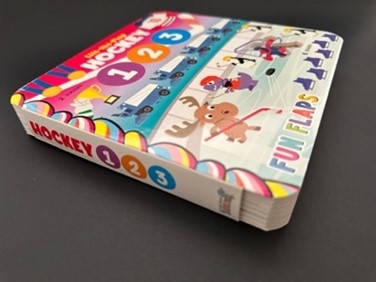
Board Book With Die Cut Panels
Here we have another rather conventional board book. Firstly, the cover spine is short. Second pages round cornered, which is not that unusual. Thirdly, the front cover is a die-cut, which we do on a number of hardback case bound books. In fact, we’ve been die-cutting covers for some of our hardback book binding competitors. What’s distinctive about this is the two pages are mounted together as per usual with the exceptions that the glue is only run around half an inch on the head, face and foot. The center 80% as indicated is not glued, each page panel has got different die-cut panels. Each of the pages have the outer head foot and spine half an inch glued so each page has a different cut big panel, two equal panels panel with a cut hole in it. To produce a job like this versus a normal hardback book in our operation the price would be increased by about 30% over a normal board book cost.
Innovative Board Books with Die-Cut Panels: A Binding and Finishing Company’s Perspective
In the competitive world of bookbinding and finishing, innovation is key to creating products that captivate and engage readers. One such innovative product is the board book with die-cut panels. This article explores the unique features and benefits of board books with die-cut panels from a binding and finishing company’s perspective, and how this distinctive technique can enhance the appeal and functionality of board books.
What are Board Books with Die-Cut Panels?
Board books with die-cut panels are sturdy, durable books typically designed for children. These books feature thick pages that are resistant to tearing, making them ideal for young readers. Die-cut panels refer to the process of cutting specific shapes or designs into the pages of the book. This technique can create windows, shapes, or intricate patterns that add an interactive and engaging element to the book.
Unique Features of Board Books with Die-Cut Panels
In a recent project, we worked on a rather conventional board book with some unique features that set it apart from typical designs:
- Short Cover Spine: The book had a short cover spine, which, while not uncommon, added to its distinctive appearance.
- Rounded Corners: The pages were round-cornered, providing a safe and smooth finish suitable for young readers.
- Die-Cut Front Cover: The front cover featured a die-cut design, a technique we frequently employ in hardback case bound books. This particular book’s die-cut front cover added an intriguing visual and tactile element.
- Unique Gluing Technique: Unlike standard board books, the pages in this book were mounted together with glue applied only around half an inch on the head, face, and foot. The center 80% was left unglued, allowing each page to have different die-cut panels.
Benefits of Die-Cut Panels in Board Books
1. Enhanced Interactivity
Die-cut panels create a more interactive reading experience. Children can peek through windows, trace shapes with their fingers, and explore different textures and layers. This tactile engagement can enhance their learning and make reading more enjoyable.
2. Visual Appeal
Die-cut designs add a visually striking element to board books. The intricate cuts and shapes can create a sense of wonder and curiosity, attracting young readers and encouraging them to explore the book further.
3. Educational Value
The die-cut panels can be used to reinforce learning concepts such as shapes, letters, and numbers. For instance, a page with a die-cut shape of an apple can be paired with text about apples, helping children make connections between the text and the visual element.
4. Durability
Despite the intricate designs, board books with die-cut panels maintain the durability that is essential for children’s books. The thick, sturdy pages can withstand rough handling, ensuring the book’s longevity.
Cost Considerations
Producing a board book with die-cut panels involves additional steps and materials compared to standard board books. In our operations, the cost of producing such a book is approximately 30% higher than that of a normal board book. This increase is due to the additional die-cutting processes and the unique gluing technique required to create the interactive panels.
Conclusion
Board books with die-cut panels offer a unique blend of durability, interactivity, and visual appeal. From a binding and finishing company’s perspective, these books represent an opportunity to provide clients with innovative and engaging products that stand out in the market.
The distinctive features, such as die-cut front covers and unique gluing techniques, showcase our ability to push the boundaries of traditional bookbinding. While the production costs are higher, the added value and appeal of die-cut panel board books can justify the investment for publishers and authors looking to create memorable and interactive reading experiences for children.
As the industry continues to evolve, embracing such creative techniques will be key to staying ahead of the competition. Board books with die-cut panels are a testament to the possibilities of innovative bookbinding and finishing, offering a compelling product that captures the imagination of young readers.
Whether you’re a publisher aiming to add a special touch to your next children’s book or a binding company seeking new solutions to offer your clients, board books with die-cut panels are worth considering. This innovative approach can make a significant impact, providing an excellent example of how creative bookbinding techniques can enhance the reading experience.
